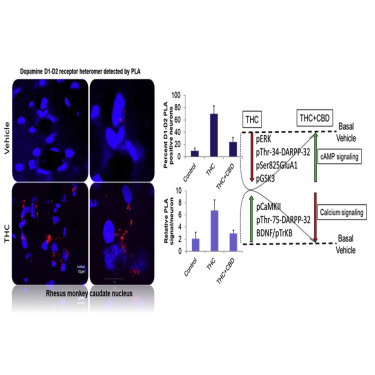iScience ( IF 4.6 ) Pub Date : 2019-12-24 , DOI: 10.1016/j.isci.2019.100794 Ahmed Hasbi 1 , Bertha K Madras 2 , Jack Bergman 2 , Stephen Kohut 2 , Zhicheng Lin 2 , Sarah L Withey 2 , Susan R George 3

|
Long-term cannabis users manifest deficits in dopaminergic functions, reflecting Δ9-tetrahydrocannabinol (THC)-induced neuroadaptive dysfunctional dopamine signaling, similar to those observed upon dopamine D1-D2 heteromer activation. The molecular mechanisms remain largely unknown. We show evolutionary and regional differences in D1-D2 heteromer abundance in mammalian striatum. Importantly, chronic THC increased the number of D1-D2 heteromer-expressing neurons, and the number of heteromers within individual neurons in adult monkey striatum. The majority of these neurons displayed a phenotype co-expressing the characteristic markers of both striatonigral and striatopallidal neurons. Furthermore, THC increased D1-D2-linked calcium signaling markers (pCaMKIIα, pThr75-DARPP-32, BDNF/pTrkB) and inhibited cyclic AMP signaling (pThr34-DARPP-32, pERK1/2, pS845-GluA1, pGSK3). Cannabidiol attenuated most but not all of these THC-induced neuroadaptations. Targeted pathway analyses linked these changes to neurological and psychological disorders. These data underline the importance of the D1-D2 receptor heteromer in cannabis use-related disorders, with THC-induced changes likely responsible for the reported adverse effects observed in heavy long-term users.
中文翻译:

Δ-四氢大麻酚增加多巴胺 D1-D2 受体异聚物并引发成年灵长类纹状体神经元的表型重编程。
长期吸食大麻的人表现出多巴胺能功能缺陷,反映了 Δ 9 -四氢大麻酚 (THC) 诱导的神经适应性功能失调的多巴胺信号传导,类似于多巴胺 D1-D2 异聚体激活时观察到的情况。分子机制仍然很大程度上未知。我们展示了哺乳动物纹状体中 D1-D2 异聚体丰度的进化和区域差异。重要的是,慢性 THC 增加了表达 D1-D2 异聚体的神经元的数量,以及成年猴纹状体中单个神经元内异聚体的数量。这些神经元中的大多数表现出共同表达纹状体黑质和纹状体苍白球神经元特征标记的表型。此外,THC 增加 D1-D2 连接的钙信号转导标记(pCaMKIIα、pThr75-DARPP-32、BDNF/pTrkB)并抑制环 AMP 信号转导(pThr34-DARPP-32、pERK1/2、pS845-GluA1、pGSK3)。大麻二酚减弱了大部分但不是全部 THC 诱导的神经适应。靶向途径分析将这些变化与神经和心理疾病联系起来。这些数据强调了 D1-D2 受体异聚体在大麻使用相关疾病中的重要性,THC 引起的变化可能是在长期大量吸食者中观察到的不良反应的原因。











































 京公网安备 11010802027423号
京公网安备 11010802027423号